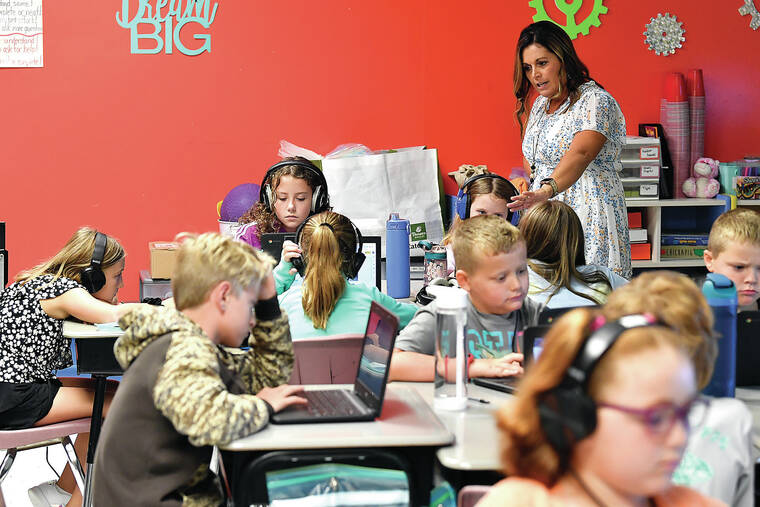Youth mental health is in crisis. Are schools doing enough?
CECILIA, Ky. — For fourth-grader Leah Rainey, the school day now begins with what her teacher calls an “emotional check-in.”
“It’s great to see you. How are you feeling?” chirps a cheery voice on her laptop screen. It asks her to click an emoji matching her state of mind: Happy. Sad. Worried. Angry. Frustrated. Calm. Silly. Tired.
ADVERTISING
Depending on the answer, Leah, 9, gets advice from a cartoon avatar on managing her mood and a few more questions: Have you eaten breakfast? Are you hurt or sick? Is everything OK at home? Is someone at school being unkind? Today, Leah chooses “silly,” but says she struggled with sadness during online learning.
At Lakewood Elementary School, all 420 students will start their days the same way this year.
The rural Kentucky school is one of thousands across the country using the technology to screen students’ state of mind and alert teachers to anyone struggling.
In some ways, this year’s back-to-school season will restore a degree of pre-pandemic normalcy: Most districts have lifted mask mandates, dropped COVID vaccine requirements and ended rules on social distancing and quarantines.
But many of the pandemic’s longer-lasting impacts remain a troubling reality for schools.
Among them: the harmful effects of isolation and remote learning on children’s emotional well-being.
Student mental health reached crisis levels last year, and the pressure on schools to figure out solutions has never been greater. Districts across the country are using federal pandemic money to hire more mental health specialists, rolling out new coping tools and expanding curriculum that prioritizes emotional health.
Still, some parents don’t believe schools should be involved in mental health at all. So-called social-emotional learning, or SEL, has become the latest political flashpoint, with conservatives saying schools use it to promote progressive ideas about race, gender and sexuality, or that a focus on well-being takes attention from academics.
But at schools like Lakewood, educators say helping students manage emotions and stress will benefit them in the classroom and throughout life.
The school, in a farming community an hour’s drive south of Louisville, has used federal money to create “take-a-break” corners in each classroom. Students can rifle through a “self-regulation kit” with tips on deep breathing, squishy stress balls and acupuncture rings, said school counselor Shelly Kerr. The school plans to build a “Reset Room” this fall, part of an emerging national trend to create campus sanctuaries where students can go to decompress and speak with a counselor.
The online student screener Lakewood uses, called Closegap, helps teachers identify shy, quiet kids who might need to talk and would have otherwise gone unnoticed.
Closegap founder Rachel Miller launched the online platform in 2019 with a few schools and saw interest explode after the pandemic hit. This year, she said, more than 3,600 U.S schools will be using the technology, which has free and premium versions.
“We are finally beginning to recognize that school is more than just teaching the kids reading, writing and arithmetic,” said Dan Domenech, executive director of the national School Superintendents Association. Just as free lunch programs are based on the idea that a hungry child can’t learn, more and more schools are embracing the idea that a cluttered or troubled mind cannot focus on schoolwork, he said.
The pandemic magnified the fragility of mental health among American youth, who had been experiencing a rise in depression, anxiety and suicidal thoughts for years, experts say.
A recent report issued by the Centers for Disease Control and Prevention found 44% of high school students said they experienced ” persistent feelings of sadness or hopelessness ” during the pandemic, with girls and LGBTQ youth reporting the highest levels of poor mental health and suicide attempts.
If a silver lining exists, the pandemic raised awareness of the crisis and helped de-stigmatize talking about mental health, while also bringing attention to schools’ shortcomings in handling it. President Joe Biden’s administration recently announced over $500 million to expand mental health services in the country’s schools, adding to federal and state money that has poured into schools to cope with pandemic-era needs.
Still, many are skeptical schools’ responses are enough.
“All of these opportunities and resources are temporary,” said junior Claire Chi, who attends State College Area High School in central Pennsylvania. Last year, her school added emergency counseling and therapy dogs, among other supports, but most of that help lasted a day or two, Chi said. And that’s “not really a mental health investment for students.” This year, the school says it has added more counselors and plans mental health training for all 10th graders.
Some critics, including many conservative parents, don’t want to see mental health support in schools in the first place.
Asra Nomani, a mom from Fairfax County, Virginia, says schools are using the mental health crisis as a “Trojan horse” to introduce liberal ideas about sexual and racial identity. She also worries schools lack the expertise to deal with student mental illness.
“Social-emotional well-being has become an excuse to intervene in the lives of children in the most intimate of ways that are both dangerous and irresponsible,” Nomani said, “because they’re in the hands of people who are not trained professionals.”
Despite the unprecedented funding, schools are having trouble hiring counselors, mirroring the shortages in other American industries.


